
“My son and I have chosen a life of evil… For this day we have been long prepared. If this is where we lose everything that we hold dear – if this is what fate has decreed for us – then we shall accept it…”
[Original title: Kozure Ōkami: Sanzu No Kawa No Ubaguruma (Wolf With Child In Tow: Perambulator Of The River Sanzu]
Director: Misumi Kenji
Starring: Wakayama Tomisaburō, Tomikawa Akihiro, Matsuo Kayo, Ayukawa Izumi, Minoru Ōki, Kishida Shin, Nitta Shôgen, Matsumoto Keppei, Hara Seishirô
Screenplay: Koike Kazuo, based upon the works of Koike Kazuo and Kojima Goseki
Synopsis: As Ogami Itto (Wakayama Tomisaburō) and his young son, Daigoro (Tomikawa Akihiro), continue to walk a lonely road as hired assassins, their deadly enemies, the Yagyū clan, plot revenge. Lord Retsudo of the Shadow Yagyū sends Ozuno (Ayukawa Izumi), head of the Kurokuwa, the Shogun’s official spies, to meet and confer with Sakaya (Matsuo Kayo), leader of the Yagyū clan in Akashi. Ozuno tells Sayaka of the duel between Ogami Itto and the chosen swordsmen of the Yagyū; and of the prior agreement made between Retsudo and Ogami that, should the latter be victorious in these fights, he and Daigoro must be left in peace. However, Ozuno further explains that Retsudo sees no reason why one of the branch clans should not pursue the family vendetta… Sayaka immediately commits herself and her clanswomen to the cause. Ozunu expresses doubt as to their being able to handle the job, and Sayaka retaliates by ordering him to select the best fighter from amongst his own band of warriors. The man chosen is ordered to escape from the room into the garden, and laughs at the ease of the mission he has been given. It is his last laugh… Ogami is contacted by Hirano Ichirobei (Matsumoto Keppei), the chamberlain of the Awa clan. The Awa have grown unusually prosperous thanks to their monopoly on indigo dye; so much so, the Shogun has grown jealous of their wealth. The chamberlain tells Ogami that spies and other agents have been sent into Awa to try and learn the secret of the dye, and to provoke a riot by the indigo farmers that would provide an excuse for Shogunate intervention. However, the Awa’s uncompromising response to this frightened the head of the farmers, Makuya Chuzaemon (Hara Seishirô), into taking refuge with the neighbouring Takamatsu clan, enemies of the Awa. Hoping to profit from the situation, the Takamatsu have reported the matter to the Shogun, who has sent three brothers, the Hidari – Benma (Minoru Ōki), Tenma (Nitta Shôgen) and Kuruma (Kishida Shin) – to escort Makuya to Edo. The brothers are fearsome warriors, known as the “Gods of Death” for their mastery of their chosen weapons. Ogami accepts the assignment for his usual fee of five hundred gold pieces, though he knows that assassinating Makuya will require him to confront the Hidari first. As Ogami and Daigoro travel towards their next meeting with fate, they are hounded and attacked by Sayaka’s clanswomen but prove up to the challenge, with Daigoro taking a hand in the despatching of the female warriors. Ogami finds himself face to face with Sayaka herself, but she eludes him. As the travellers pass through a forest, they are then set upon by Ozunu’s men, but again emerge victorious; though three of their attackers survive the conflict and slip away… Ogami is wounded during this battle, and can only struggle to a dilapidated hut before collapsing, leaving the young Daigoro to try and tend his father. Their followers decimated, Sayaka and Ozunu meet to re-think their plans. Ignoring Sayaka’s protest against the meanness of the tactics, Ozunu proposes a new kind of attack upon Ogami: the kidnapping of Daigoro…
Comments: In my review of Sword Of Vengeance, I made reference to the fact that most Westerners were first exposed to the amazing “Lone Wolf And Cub” films via Shogun Assassin, an English-dubbed, story-light, action-heavy cobbling together of the first two installments in the series, Sword Of Vengeance itself and its first sequel, Baby Cart At The River Styx.


However, it was the latter film that provided the bulk of Shogun Assassin’s footage, and for a very good reason. While sprinkled with unforgettably bloody fight sequences, Sword Of Vengeance spends much of its running-time establishing its historical background, depicting the fall from grace of its stony-faced anti-hero, Ogami Itto, and delineating the sequence of events that saw the former Shogunate executioner become a wandering assassin. With this out of the way, Baby Cart At The River Styx was free to focus purely upon Ogami’s quest to carry out his latest assignment, his inevitable apocalyptic showdown with “the Gods of Death”, and the machinations of the deadly and treacherous Yagyū clan-members as they pursued their vendetta against him.
The result is a staggering piece of work. Quentin Tarantino’s homages notwithstanding, you’d travel a long way to see a movie with a higher body count, more severed limbs, or a greater litres-of-blood-spilled to minutes-of-film ratio than this one.
Yet to call Baby Cart At The River Styx a mere “action film” is to do it a severe disservice. Like its predecessor, the film is an artistic marvel, finding a remarkable beauty, even poetry, in its scenes of carnage. It also boasts as many moral shades of grey as it does geysers of arterial blood. Far more than the original film, Baby Cart At The River Styx insists upon Ogami’s “killer for hire” status. While the ronin’s Sword Of Vengeance assignment, preventing the overthrow of an heir to a throne by a band of traitors and mercenaries, had some honour to it, there is nothing very uplifting about the purely financial squabble between the Shogun and the Awa officialdom that sets Ogami in motion here.
Ignoble as Ogami’s task may be, given the events of Sword Of Vengeance the viewer is automatically anti-Shogun; although it is, of course, impossible to judge whether the impassive Ogami feels the same way.


But no matter: the Awa clan can pay the fee that Ogami demands, and so he accepts the assignment.
That Ogami’s mission will inevitably bring him into direct and fatal conflict with the Hidari brothers, three men of honour as refined as his own, who have committed no crime or discreditable act, muddies the waters still further.
And finally, we learn that Daigoro – talking now, but still just a toddler, and as gosh-darn cute as ever – has joined his father in the family business.
Baby Cart At The River Styx is one of those movies that provides a salutary reminder of the profound philosophical differences between Eastern and Western film-making. Given the extreme Western sensitivity about the juxtapositioning of children and violence in motion pictures, whether they be the victims or the perpetrators, it is likely that for some viewers, the sight of Daigoro not just in the most extreme peril, but playing an active role in his father’s wholesale slaughter of his enemies, will be the most controversial part of this film, and perhaps the most difficult to watch.
The film wastes no time getting down to business. Its opening scene reminds us what it’s all about by showing Ogami under attack by two Yagyū, the first of whom has a sword slammed – with the most perfect symmetry – into his head and down the middle of his forehead, while the second is impaled mid-air with a naginata assembled from parts of Daigoro’s cart.
This grotesquely bloody scene also offers a reminder that these films can be disconcertingly funny. “We Yagyū have spread all over Japan!” announces Ogami’s first attacker, as his dying colleague’s provides proof of this assertion by redecorating the immediate countryside with his arterial blood-spray. “No matter where you go, there is no way you can escape from us!” he adds, before remembering that he has, you know, a sword embedded in his skull, and belatedly keeling over.
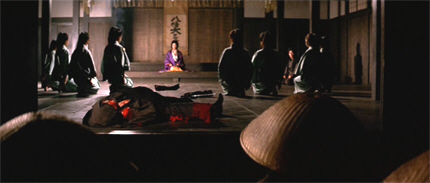
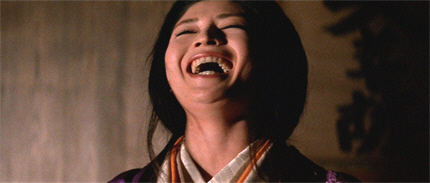
This bloody opener is followed by one of those quiet interludes that are, in their way, even more disconcerting: we watch Ogami parenting Daigoro—in this case, washing him gently as the two share a bath in their room at an inn, and teaching him to count.
Meanwhile, we learn of a conspiracy between the Shogun and the Shadow Yagyū. The former uses the head of his official band of spies, the Kurokuwa, to deliver a message from the treacherous Retsudo to Sayaka, the head of one of the Yagyū branch-clans. Though overtly holding to the letter of his agreement that Ogami and Daigoro should be left in peace by the Yagyū, Retsudo has no intention of adhering to the spirit of the arrangement. Instead, since technically the agreement only applies to the Edo Yagyū, he plans to get around it by recruiting the clan’s more geographically scattered off-shoots—like Sayaka’s, which is based in Akashi.
Matsuo Kayo’s Sayaka is one of the best and most intriguing things about Baby Cart At The River Styx. She displays her villainy credentials here via an eye-twitch, and by punctuating her enraged threats against Ogami with lengthy shrieks of laughter – “AAAH-HA-HA-HA-HA-HA-HA!!” – before abruptly subsiding into mask-like gravity.
Sayaka is served by an all-female band of warriors, the members of which trip about demurely like the dozen little maids from school before whipping out their weapons to demonstrate their talents upon the person of Ozuno’s “strongest fighter”: ears, fingers, a nose and various limbs go flying before the hubristic warrior is finally dispatched.
Rightly impressed, Ozuno tells Sayaka that in two days’ time, Ogami will be passing through Akashi territory.


Ozuno knows this because, in spite of the agreement, Yagyū spies dog his every move. Ogami remains on high alert at all times, however, and quite a number of these spies pay with their lives for their transgression—including the one that monitors the meeting between Ogami and his next potential employers, which takes place (most inappropriately, we feel) at a religious sanctuary.
It is here that we learn how people go about hiring Ogami, a system apparently devised by a “great warrior” of previous times: they leave “amulets of evil” at sanctuaries built along the side of the main roadway; while Ogami, in turn, leaves rocks in symbolic patterns that indicate where he may be found.
Thus Ogami is found by the Awa chamberlain and his retinue. Their meeting begins with the inevitable demand that Ogami prove his identity – always a highlight of these films – and this time he does so by suddenly flinging his sword through the air. It flies straight through the chamber’s paper walls, embedding itself in the more substantial wall of the outer room—and, as it turns out, in the body of the lurking Yagyū spy beyond: something which poses some slight difficulty for the chamberlain’s followers, when they are sent to retrieve the weapon.
That settled, the chamberlain unfolds his difficulty to Ogami, who sits silent and motionless, absorbing the details of the situation.
There is, as I have said, nothing remotely honourable about this assignment: it is purely killing for hire, justified only by the Shogun’s own dirty tactics; but a job is a job, and five hundred gold pieces, five hundred pieces…


It is only when the chamberlain mentions the Hidari brothers that Ogami opens his eyes, and sits up both literally and figuratively:
“These are the three brothers that even the Yagyū clansmen are afraid of: Hidari Benma, Tenma and Kuruma. The three are masters of the Takeuchi-Harness Techniques. Benma uses a hand armour-claw; Tenma uses a flying club; and Kuruma uses a mailed fist. They are infamous for their expertise; often called ‘the Gods of Death’…”
The chamberlain tells Ogami that the ship carrying the Hidari brothers, on their way to collect Makuya from the Takamatsu clan, is due to arrive at a port in Akashi in two days’ time. He suggests that Ogami board the same ship.
The assassin therefore sets out through Akashi territory. As always, he is on high alert; though at first glance, there is nothing very threatening about the small troop of female acrobats entertaining some local people by the road up ahead; nor the two pilgrims travelling the same road in the opposite direction; and least of all about another cluster of women, further along the road, cleaning their harvested vegetables in a roadside stream…
Typically for this film, the subsequent battle with the Akashi Yagyū clanswomen is simultaneously funny and disturbing: few details in this series crack me up quite as much as the sudden production of a deadly weapon from within—a daikon radish!! (The cart, when it trundles off down the road again, still has a radish embedded in it…)
But the fight itself is something else—not because of the bloody slaughter of a group of women: that is one of the things I enjoy about Asian movies; the women fight as hard, kill as hard, and die as hard as the men.


However, this is the point at which Daigoro begins to take an independent hand in his father’s fights, as opposed to him – and his cart – being used as a weapon, and a supply of weapons.
Granted, he does it at first in pure self-defence. This first wave of Akashi fighters – and we should note this point, in light of future developments – have no hesitation at striking at the child; and Daigoro loses, if not his life, at least most of his top-knot. As his father holds off two of the swordswomen, a third attacks him—prompting him to release a spring on the side of his cart, so that the on-rushing Akashi finds herself impaled upon a hidden naginata.
Leaving behind a trail of bodies, Ogami and Daigoro move on—only to be assaulted yet again, and to fall foul of a net-trap. Ogami manages to cut himself free before the single female attacker can strike at him, however, and finds himself confronted by someone who proudly announces herself to be Sayaka, of the Yagyū…
In the battle that follows, Sayaka succeeds in doing what no-one else so far has: she wounds Ogami Itto, and holds off his retaliatory attack upon her. Even so, to escape him must jump literally out of her clothes; and she retreats in that disconcerting backwards stutter that we sometimes find in films of this nature.
But even now Ogami is not free of pursuit. On the contrary, he finds himself confronted by a wall of Yagyū fighters. It is here that Daigoro takes a more active role in the battle…and in a most unexpected way: Ogami’s first move is to thrust his child’s cart towards his attackers who, understandably, simply stand and stare. At the last moment, Daigoro flips another switch—and mows down several of the Yagyū ankle-high via the spring-blades in his cart’s wheels.
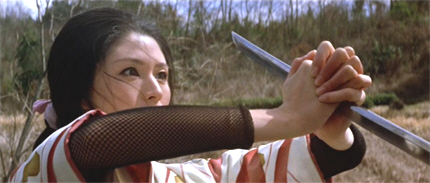

Their numbers reduced, Ogami is able to account for the remaining Yagyū, wielding a two-bladed naginata with savage efficiency. Finally, the remaining three Yagyū – one of whom is Ozuno himself – decide that discretion is the better part of valour, and slip away through the trees…
Ogami and Daigoro go on their way, at last unmolested; but Ogami is both exhausted and injured, and makes it only so far as an isolated roadside hut before collapsing.
Left to his own devices, Daigoro makes heroic efforts to care for his father, first carrying to him a small supply of water – after several failed attempts to carry some in his tiny hands, Daigoro transports it in his own mouth – and then wrestling with his conscience over an offering of buns left at a nearby shrine. After looking thoughtfully into the placid face of the stone Buddha and bowing his head in prayer, Daigoro strips off his own jacket and leaves it at the shrine in exchange for the buns, which he carries back to his father.
Meanwhile, in the wake of the slaughter of their troops, Sayaka and Ozuno regroup. Sayaka is now fully committed to the killing of Ogami, in order to restore her clan’s lost honour; but Ozuno retreats somewhat—not from the task, but from the frontal assault. He suggests the kidnapping of Daigoro…
Ozuno argues that Ogami is fighting to restore his House, for the benefit of Daigoro; and that the extermination of the Yagyū is a means to this end. However, should Daigoro be lost, so too should Ogami’s motivation and hope for the future.


Sayaka is outraged and offended by what she considers cowardly, dishonourable tactics, but Ozuno presses the point:
“‘Kill Ogami Itto at any cost, and by any means.’ That was Lord Retsudo’s order…”
And Sayaka reluctantly accedes.
The other two of Ozuno’s men, who followed Ogami and Daigoro to the hut and witnessed the former’s collapse, are sent on their way with a silent gesture from their lord.
As he watches over his sleeping father, Daigoro’s attention is drawn to the sound of music nearby. Curious, he wanders outside the hut, to find the source of the sound…
Left with no choice, a silent Ogami follows his enemies to their camp, where he finds Sayaka and Ozuno—the latter holding Daigoro suspended by a rope thrown over a branch, which leaves the child dangling over a well reputed to be bottomless…
Ogami refuses Ozuno’s order to throw down his sword, replying stoically that if they must kill Daigoro, so be it; but what for? “Have you Kurokuwa clansmen become vassals of the Yagyū?” he sneers.
Ozuno taunts Ogami in turn, trying to provoke him into showing how much the situation hurts him, to get some admission of vulnerability. However, Ogami’s eyes slide by him to his son.
“Daigoro,” he says quietly, “your mother is waiting for you at the River of Sanzu…”


(So she is: the English-language rendering of this film’s title gives it as the more familiar “River Styx” but its equivalent in Japanese Buddhist mythology is the Sanzu, which must be crossed by one of three increasingly dangerous paths before a soul can enter the afterlife: which path being determined by the individual’s load of sin.)
“Do you understand?” Ogami concludes, and apparently Daigoro does: he kicks off his one remaining sandal, which drops down into the well—eventually striking water, despite the well’s reputation.
There is a frozen moment, during which Ozuno and Sayaka (whose eye-twitch is back) stare at Ogami in confusion and growing alarm. Then Ogami attacks, quickly slaying the two henchman.
To Sayaka’s horror, Ozuno releases the rope by which Daigoro is suspended and plunges into the fight, leaving the child to hurtle into the depths of the well. In the bare seconds left to him, Ogami bloodily dispatches Ozuno and slams his foot down on the uncoiling rope.
Sayaka makes no move to join the battle, nor does Ogami seem to think she will: though keeping a wary eye upon her, he sheathes his sword before drawing Daigoro up from the well—at which point the little boy is found to be soaking wet, to the height of his waist…
The two greet each other in their accustomed, undemonstrative way; but as Ogami wrings the water from his child’s robe, and contemplates the well, there is unusual emotion in his eyes; and he goes so far as to add a comforting pat on the back.
The two begin to move away, and still Sayaka does not lift a hand—not even when Ogami turns his back on her. Or perhaps, to do her justice—least of all then.
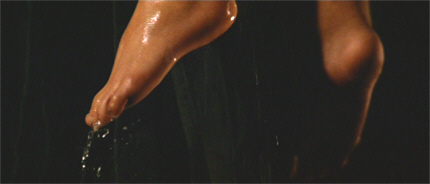

When we catch up with them again, Ogami and Daigoro have indeed taken their places on the boat that is also carrying the Hidari brothers. Along for the ride are quite a number of other travellers—among them a subdued Sayaka, who keeps herself concealed, and a band of fighters hired by the Awa clan. The latter take the first opportunity to attack the Hidari, and we get our first look at the brothers’ brutally efficient fighting style. One of the hired guns is literally so – hmmph! I expressed my opinion of that sort of people re: Sword Of Vengeance; and this one gets what he deserves too…
In the aftermath, the cabin below is deserted except for the brothers, Ogami and a sleeping Daigoro, and the last remaining hired killer, who is plotting his next move when one of the Hidari extracts a small knife from an in-built sheath on his sword and flings it across the room. It buries itself in the wall next to Ogami, who doesn’t react, having on its way neatly sliced off the layer of skin at the very tip of the nose of the remaining killer—who, after an incredulous moment, flees the room with a howl of terror.
“Pardon me,” remarks Benma, “would you mind returning my knife?”
With as much of a smile as we ever get from him, Ogami does so—throwing the weapon across the room and back into its sheath in a single, easy gesture…which also serves to answer any other questions the Hidaris may have had.
It is the middle of the night, and all is quiet, before Sayaka makes her move. She discovers that the cargo marked as ‘soy sauce’ is actually oil, and recognises another Awa tactic; but before she can take any action, the remaining hired killer – his nose bandaged in a bandanna – tips over one of the drums and sets the spilled oil alight. As the burning river slips down the stairs, trapping the cabin passengers below deck, the hired killer jumps overboard.


As the terrified crew tries to fight the fire above decks, below, Ogami and the Hidari take the situation in their stride—the latter going so far as to tell Ogami their future movements; adding that while they never attack first, nor will they stop until they have dispatched anyone who interferes with them, no matter who that might be…
“I hear there’s an assassin called ‘Lone Wolf and Cub’,” remarks Kuruma; while Benma adds, “But if such an assassin can’t escape a fire, what good is he?”
The brothers do escape, wrapping themselves in their cloaks, dashing through the fire, and putting out the flames that threaten to overwhelm them by leaping overboard. Ogami, meanwhile, cuts a passage up to the deck with his sword. He barely rescues Daigoro’s cart – putting the boy in it, to free his hands to beat out the flames! – then, pausing only to extract from it two halves of a naginata, he throws cart and child overboard…following via pole-vault. As the ship is engulfed in flames, Ogami swims for shore, pushing the cart ahead of himself.
Only yards behind Ogami is another escapee from the boat: Sayaka, her sword clenched in her teeth. As she draws near, Ogami seizes and manages to disarm her; he then tows her ashore with his one free arm.
The story of Baby Cart At The River Styx unfolds during the winter, meaning that its action plays out in front of a variety of bleak landscapes, rather than the ironically sun-drenched back-drops of Sword Of Vengeance. Consequently, though Ogami, Daigoro and Sayaka escape the burning ship, when they drag themselves onshore and into a nearby refuge, which has no capacity for building a fire, they are in danger of dying of cold.


Ogami’s way of dealing with this is abruptly to the point, if open to misinterpretation. He strips off Daigoro’s wet clothing and his own, then immediately grabs Sayaka and strips her too, in spite of her rage and terror. Ogami pays no heed to her violent struggles, however, finally throwing her to the ground—not to molest her, as she so obviously fears, but to draw her into a tight embrace, with Daigoro between the two of them, such that their mutual body heat will allow them to survive through the night.
Bewildered, and unsure of her own emotions, Sayaka’s first impulse is to reach for Ogami’s sword, so temptingly close. It is Daigoro who stops her. Held between the adults, he is presented with a stark physical contrast: curiously, he pats his father’s flat, muscled chest—and then taps one of Sayaka’s breasts, sending a stream of water-droplets to the ground…
Other than with respect to Ogami himself, the ‘Lone Wolf’ films are not much given to analysing their characters’ motivations, nor to granting them any particular psychological depth. Sayaka is the exception to that generalisation. She is at first happy enough to ally herself with the Yagyū cause, and later has her clanswomen to avenge; but her attitude towards Ogami undergoes a progressive change as they interact. Reluctant admiration of him, mingling with her discomfort with the dishonourable tactics adopted by Ozuno – and by extension, Retsudo – causes her to reconsider her position, even before Daigoro’s playful touch disarms her as completely in the figurative sense as his father did literally only moments before.
Though there is no doubt that the boy, and the relationship between father and son, has stirred something in her, it is, however – thank goodness! – far more complicated a matter than simply a woman reacting to a child: we see that clearly enough in the earlier assault made by Sayaka’s clanswomen. It is, rather, the uncomfortable shifting of the line in the sand: Sayaka is that most oxymoronic of individuals, an honourable Yagyū; she must decide whether her obligations to her treacherous clan supersede her own sense of honour—particularly in dealing with a man whose own code is, unlike that of her allies, set in stone. It is with a peculiar kind of trust that Sayaka finally relaxes in her enemy’s pragmatic embrace.


The next morning, Sayaka silently dresses herself and slips away…
Meanwhile, the Hidari brothers are carrying out their mission exactly as they told Ogami they would: leading a retinue that includes Makuya Chuzaemon, who is being carried in a palanquin, across the sand dunes of Oura, in order to meet the boat that is to carry them back to Edo.
Though everything around them appears desolate and lonely, the brothers know that with so much at stake, the Awa will try to stop them. It is Benma, he of the metal claw, who first grasps where their enemies are hiding: abruptly, he slams his claw down through the sand—through, also the concealing mat immediately below that surface, and through the skull of the hidden Awa clansman, as the sand runs red… Hidden enemy after hidden enemy is brutally dragged to the surface, until the rest fling away their concealment and join the fight.
The bloody encounter leaves the dunes strewn with the Awa dead, and the Hidari catching their breath—safe for the moment; so they think; until they find themselves confronted by Daigoro. He points silently to the top of the sand dune that stands between the brothers and the waiting boat.
It is the nature of these films to climax in an epic battle; and if the enemies here are less numerous than usual, they pose no less of a threat. But not even the combined skill of the Hidari brothers is enough to counter that of Ogami Itto; not when he has already accepted 500 gold pieces…
Though blood and body-parts are thrown around with great enthusiasm right from the outset of Baby Cart At The River Styx, the film-makers save a few of their most grotesque touches for this fight.


These include a split head spraying like a fountain, and a philosophical dissertation from Hidari Benma about how he always wanted to hear the famous wailing sound – “the Whistling of Wintry Wind”, so-called – associated with a particular, delicately executed neck-wound…
…just not from his own neck.
Of course, that’s not the end of the job—though what follows is deliberately, almost absurdly anti-climactic; and no less so because Makuya’s blood literally coats the camera-lens, as Ogami turns away.
Ogami and Daigoro then resume their lonely journey. Suddenly, as they enter the edge of a forest, Ogami draws his sword, holding it out from his side as a warning—
—a warning to the following Sayaka, that they are enemies again, and that she is not to approach.
With a last despairing look, Sayaka disappears among the trees…
…though hopefully not from the series…
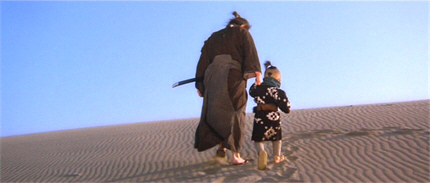


My introduction to the “Lone Wolf and Cub” movies was the Bob’s Burgers episode “Hawk & Chick”
https://www.imdb.com/title/tt4622318/
LikeLike
I haven’t seen that one! – I’ll have to keep an eye out.
LikeLike
They played this about a month or so ago on TCM. They claimed to be showing the entire series but only showed the first four, which was annoying because I was really enjoying the series and wanted to see how it ended.
LikeLike
Well…I won’t go so far as to say you’ll get them all here, but I like to think you will. 🙂
LikeLiked by 1 person
I think the old version of this review was not the first I’d heard of these movies, but it was the one that persuaded me to rent them.
LikeLike
I hope I haven’t changed things here too much for you!
LikeLiked by 1 person